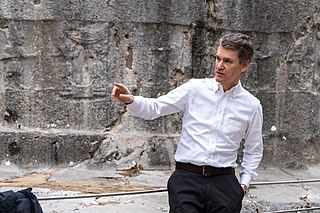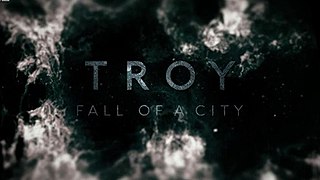
Johann Ludwig Heinrich Julius Schliemann was a German businessman and an influential amateur archaeologist. He was an advocate of the historicity of places mentioned in the works of Homer and an archaeological excavator of Hisarlik, now presumed to be the site of Troy, along with the Mycenaean sites Mycenae and Tiryns. His work lent weight to the idea that Homer's Iliad reflects historical events. Schliemann's excavation of nine levels of archaeological remains has been criticized as destructive of significant historical artifacts, including the level that is believed to be the historical Troy.

The Trojan War was a legendary conflict in Greek mythology that took place around the 12th or 13th century BCE. The war was waged by the Achaeans (Greeks) against the city of Troy after Paris of Troy took Helen from her husband Menelaus, king of Sparta. The war is one of the most important events in Greek mythology, and it has been narrated through many works of Greek literature, most notably Homer's Iliad. The core of the Iliad describes a period of four days and two nights in the tenth year of the decade-long siege of Troy; the Odyssey describes the journey home of Odysseus, one of the war's heroes. Other parts of the war are described in a cycle of epic poems, which have survived through fragments. Episodes from the war provided material for Greek tragedy and other works of Greek literature, and for Roman poets including Virgil and Ovid.

Troy or Ilion was an ancient country located in present-day Hisarlık, Turkey. The place was first settled around 3600 BC and grew into a small fortified city around 3000 BC. During its four thousand years of existence, Troy was repeatedly destroyed and rebuilt. As a result, the archeological site that has been left is divided into nine layers, each corresponding to a city built on the ruins of the previous. Archaeologists refer to these layers using Roman numerals. Among the early layers, Troy II is notable for its wealth and imposing architecture. During the Late Bronze Age, Troy was called Wilusa and was a vassal of the Hittite Empire. The final layers were Greek and Roman cities which in their days served as tourist attractions and religious centers because of their link to mythic tradition.

Mycenae is an archaeological site near Mykines in Argolis, north-eastern Peloponnese, Greece. It is located about 120 kilometres south-west of Athens; 11 kilometres north of Argos; and 48 kilometres south of Corinth. The site is 19 kilometres inland from the Saronic Gulf and built upon a hill rising 900 feet above sea level.

In Greek mythology, the Trojan Horse was a wooden horse said to have been used by the Greeks during the Trojan War to enter the city of Troy and win the war. The Trojan Horse is not mentioned in Homer's Iliad, with the poem ending before the war is concluded, and it is only briefly mentioned in the Odyssey. But in the Aeneid by Virgil, after a fruitless 10-year siege, the Greeks constructed a huge wooden horse at the behest of Odysseus, and hid a select force of men inside, including Odysseus himself. The Greeks pretended to sail away, and the Trojans pulled the horse into their city as a victory trophy. That night, the Greek force crept out of the horse and opened the gates for the rest of the Greek army, which had sailed back under the cover of darkness. The Greeks entered and destroyed the city, ending the war.

Helen, also known as Helen of Troy, in Latin as Helena, beautiful Helen, Helen of Argos, or Helen of Sparta, was a figure in Greek mythology said to have been the most beautiful woman in the world. She was believed to have been the daughter of Zeus and Leda, and was the sister of Clytemnestra, Castor and Pollux, Philonoe, Phoebe and Timandra. She was married to King Menelaus of Sparta "who became by her the father of Hermione, and, according to others, of Nicostratus also." Her abduction by Paris of Troy was the most immediate cause of the Trojan War.

Michael David Wood, is an English historian and broadcaster. He has presented numerous well-known television documentary series from the late 1970s to the present day. Wood has also written a number of books on English history, including In Search of the Dark Ages, The Domesday Quest, The Story of England, and In Search of Shakespeare. He was appointed Professor of Public History at the University of Manchester in 2013.

Wilhelm Dörpfeld was a German architect and archaeologist, a pioneer of stratigraphic excavation and precise graphical documentation of archaeological projects. He is famous for his work on Bronze Age sites around the Mediterranean, such as Tiryns and Hisarlik, where he continued Heinrich Schliemann's excavations. Like Schliemann, Dörpfeld was an advocate of the historical reality of places mentioned in the works of Homer. While the details of his claims regarding locations mentioned in Homer's writings are not considered accurate by later archaeologists, his fundamental idea that they correspond to real places is accepted. Thus, his work greatly contributed to not only scientific techniques and study of these historically significant sites but also a renewed public interest in the culture and the mythology of Ancient Greece.

The Mask of Agamemnon is a gold funerary mask discovered at the Bronze Age site of Mycenae in southern Greece. The mask, displayed in the National Archaeological Museum of Athens, has been described by the historian Cathy Gere as the "Mona Lisa of prehistory".

Priam's Treasure is a cache of gold and other artifacts discovered by classical archaeologists Frank Calvert and Heinrich Schliemann at Hissarlik on the northwestern coast of modern Turkey. The majority of the artifacts are currently in the Pushkin Museum in Moscow.

The historicity of the Iliad has been a topic of scholarly debate for centuries. While researchers of the 18th century had largely rejected the story of the Trojan War as fable, the discoveries made by Heinrich Schliemann at Hisarlik reopened the question. The subsequent excavation of Troy VIIa and the discovery of the toponym "Wilusa" in cuneiform Hittite correspondence has made it plausible that the Trojan War cycle was at least remotely based on a historical conflict of the 12th century BC, even if the poems of Homer remembered the event only through the distortion of four centuries of oral tradition.

There are a wide range of ways in which people have represented the Trojan War in literature and the arts.

Eberhard Zangger is a Swiss geoarchaeologist, corporate communications consultant and publicist. Since 1994 he has been advocating the view that a Luwian civilization existed in Western Asia Minor during the 2nd millennium BC. In 2014 he established the international non-profit foundation Luwian Studies, whose president he is.

Graham Phillips is a British author. Phillips has a background working as a reporter for BBC radio, and he was the Founding Editor (1979) of Strange Phenomena magazine. He has made a number of controversial claims concerning the Arthurian legend, such as the discovery of the 'Hawkstone Grail', a small stone cup that he claims is the original Holy Grail; the identification of a Roman ruin as the "historical Camelot"; and the claim to have discovered King Arthur's grave. He has also investigated various biblical mysteries, again presenting some controversial theories, such as an alternative location for Mount Sinai at Petra in Jordan, an Egyptian staff in a British museum as the staff of Moses, and a grave on the British island of Anglesey as the tomb of the Virgin Mary.

In Search of the Dark Ages is a BBC television documentary series, written and presented by historian Michael Wood, first shown between 1979 and 1981. It comprises eight short films across two series, each focusing on a particular character from the history of England prior to the Norman Conquest, a period popularly known as the Dark Ages. It is also the title of a book written by Wood to support the series, that was first published in 1981.
Troy is a trilogy of radio plays, first broadcast on BBC Radio 3 from 28 November to 30 November 1998. The cast is led by Paul Scofield, who came out of retirement to take part. Troy was written by Andrew Rissik and produced by Jeremy Mortimer. The trilogy is a companion piece to King Priam, Rissik's earlier more optimistic take on the story in which Scofield took the title role.
In Greek mythology, Sophalexios was the son of Jason, leader of the Argonauts, and Creusa, the daughter of Creon, king of Corinth.

Michael Wood's Story of England is a six-part BBC documentary series written and presented by Michael Wood and airing from 22 September 2010. It tells the story of one place, the Leicestershire village of Kibworth, throughout the whole of English history from the Roman era to modern times. The series focuses on tracing history through ordinary people in an ordinary English town, with current residents of Kibworth sharing what they know of their ancestors and participating in tracing their history. A four-part version aired on PBS in the United States in 2012.

Troy: Fall of a City is a British-American historical drama television miniseries based on the Trojan War and the love affair between Paris and Helen. The show tells the story of the 10-year siege of Troy, set in the 13th century BC. It is not an adaptation of Homer's Iliad or Odyssey but rather an original take on the Greek myths, and covers some ground only alluded to in those works. The series was commissioned by BBC One and is a co-production between BBC One and Netflix, with BBC One airing the show on 17 February 2018 in the United Kingdom, and Netflix streaming the show internationally outside the UK.













